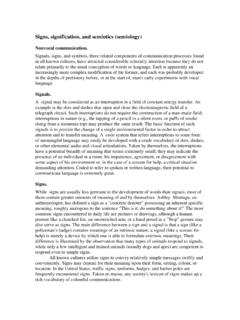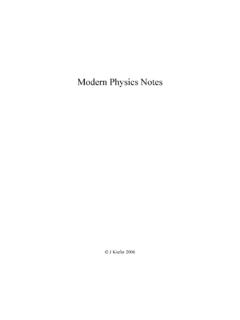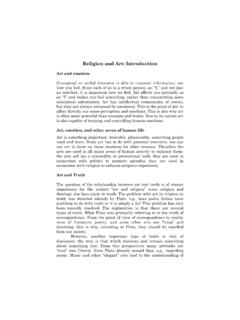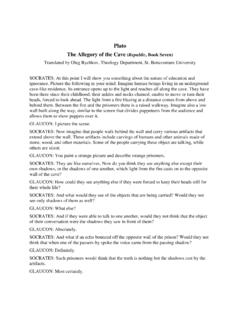Transcription of Structuralism 1. The nature of meaning or understanding.
1 Structuralism 1. The nature of meaning or understanding . A. The role of structure as the system of relationships Something can only be understood ( , a meaning can be constructed) within a certain system of relationships (or structure). For example, a word which is a linguistic sign (something that stands for something else) can only be understood within a certain conventional system of signs, which is language, and not by itself (cf. the word / sound combination and shark in English and Arabic). A particular relationship within a society ( , between a male offspring and his maternal uncle) can only be understood in the context of the whole system of kinship ( , matrilineal or patrilineal). Structuralism holds that, according to the human way of understanding things, particular elements have no absolute meaning or value: their meaning or value is relative to other elements.
2 Everything makes sense only in relation to something else. An element cannot be perceived by itself. In order to understand a particular element we need to study the whole system of relationships or structure (this approach is also exactly the same as Malinowski's: one cannot understand particular elements of culture out of the context of that culture). A particular element can only be studied as part of a greater structure. In fact, the only thing that can be studied is not particular elements or objects but relationships within a system. Our human world, so to speak, is made up of relationships, which make up permanent structures of the human mind. B. The role of oppositions / pairs of binary oppositions Structuralism holds that understanding can only happen if clearly defined or significant.
3 (= essential) differences are present which are called oppositions (or binary oppositions since they come in pairs). This means that meaning is not something absolute but relative and depends on binary oppositions. We cannot understand something unless we first perceive how it is different from something else, or its opposition. For example, there is no meaning hot unless there is also cold, no good without evil, no male . without female and so on. All terms, so to say, generate their opposites. In fact, it is selecting these significant differences (opposites) that creates the world of objects for our mind. , there would not be native without us perceiving our difference from foreign, and there wouldn't even be the human person if we didn't perceive our difference from other human beings!
4 One very important area where oppositions / significant differences are crucial is language where oppositions between sounds / words are crucial for understanding . For example, the only sound that makes the words dog and dock different is the last one. If we make sounds g and k indistinguishable in pronouncing them, we could not tell these two words apart: it means that g / k is a significant difference or opposition that is crucial to understanding . On the other hand, even if we pronounce the word rock with a rolling R (as Italians or Russians) we can still understand it: therefore r / R is not a 2. significant difference or opposition crucial to our understanding . (Thus what determines if we can understand someone's accent is whether this person can create enough difference between sounds that constitute binary oppositions that are significant for this language.)
5 These observations prove the existence of a structural principle in language: in language what makes any single item meaningful is not its particular individual quality but the difference between this quality and that of other sounds / words, or its position within the structure (system of relationships). These observations were made by Ferdinand de Saussure, in the Course in General Linguistics. 2. Levi-Strauss and structural anthropology; structural method applied to culture Language is not the only area where structural principles can be applied. Anthropologists apply them to societies and kinship systems. Levi-Strauss also tried to apply structural principles to cultural phenomena such as mythology. According to Levi-Strauss, myth can be organized according to a certain structure, just as language.
6 In language this structure can be roughly called grammar which is based on its system of significant differences or oppositions. Myth also has its system of oppositions and grammar. If we know this grammar of myth well enough we might be able to decipher the message . that myth is trying to convey to us. When we master the grammar of myths we can read their hidden messages, much as we can read between the lines for political statements and agendas in newspapers. However, in order to read myths successfully, we must know the whole system of relationships in a particular myth, or its structure. This is what Levi-Strauss is attempting to do in his Story of Asdiwal.. 3. Roland Barthes and semiology Structuralism is the theory that conceives of all cultural phenomena as sign systems, operating according to the rules of a deep structure.
7 The simplest example of a sign system is traffic lights or road signs. A sign is arbitrary, but cannot be viewed outside of a system of signs. Ferdinand de Saussure, in the Course in General Linguistics, describes language as a system of signs (a word is a sign) to which we respond in a predictable way. According to him, the sign is made up of a signifier ( , the acoustic form of the word, the sound) and a signified ( , a mental concept). These two are combined in the mind resulting in understanding or meaning ( , perceiving the sound cat signals the object cat ). The bond between the signifier and the signified is arbitrary; any word can be used to signify anything. Saussure also envisaged semiology (semiotics) as a science of signs in general, not only linguistic signs (words).
8 Language is only one of the systems that is studied by semiotics. 3. Semiotics was viewed by Saussure as a key to unlocking a variety of cultural phenomena all of which are various sign systems. Thus culture operates by constructing systems of conventional oppositions that fall into conventional sign systems, or system of cultural codes that can be read as text, language, or messages. This is called cultural construction of meaning , or social construction of reality. (Incidentally, this is important for the idea of difference, for some of the oppositions constructed by culture can affect how different groups of humans are perceived and treated, , if they fit within an opposition savage-civilized etc.). Roland Barthes helped found the modern science of semiology, applying structuralist (or semiotic) methods to the myths that he saw all around him: media, fashion, art, photography, architecture, literature.
9 According to Barthes, anything in culture can be a sign and send a specific message. In his Mythologies Barthes describes some methods of deciphering these messages. According to Barthes, myth is a type of speech (the original meaning of the Greek mythos: word, speech, story). Myth is a system of communication or a message, a mode of signification. This means that everything can be myth, provided that it conveys some meaning or message (cf. cultural signs and icons). Since language is the universal method of communication in humans, we can potentially convert everything into language. Speech of this kind [ , myth] is a message so it is not confined to oral or written speech. So a photograph is a kind of speech, in the same way as a newspaper article. If an object means something it becomes speech.
10 Myth as a semiological [or semiotic] system ; mythology is part of the science of semiology discovered by Saussure. The main principles of Barthes' analysis of myths is that: myth is something hidden and needs to be uncovered myth has a message and intent and needs to be deciphered Type of social Binary (significant) Element in a Deciphering phenomenon oppositions system/structure message language dog-doc this-dis shark understanding rock-Rock got-g^t garb language grammar society sister-brother maternal uncle in understanding social foreign-native matrilineal society structure myth same as above mythical structure? mythical message? 4. How one would approach the study of myth structurally: 1. By understanding a culture as a text or language phenomenon: identifying significant binary oppositions (for example ocean/land would not be significant for someone who lives in a desert), determining how they are related, and building a structure 2.



